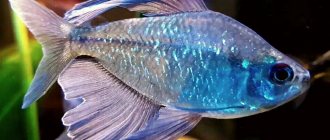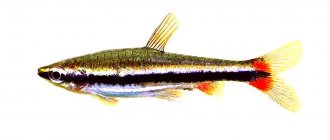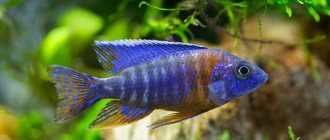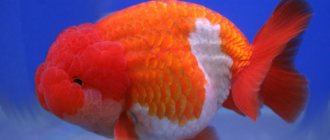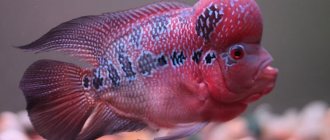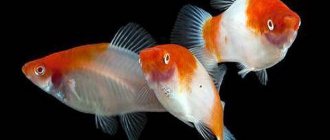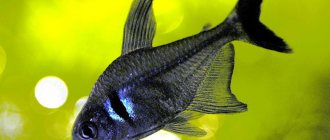Types of fish
| Cichla ocellus | |
| Scientific classification | |
| Kingdom: | Animalia |
| Type: | Chordata |
| Class: | Actinopterygia |
| Order: | Cichliformes |
| Family: | Cichlids |
| Genus: | Cichla |
| Variety: | C. ocellaris |
| Binomial name | |
| Cichla ocellata Bloch and J. G. Schneider, 1801 | |
Cichla ocellaris
, sometimes known as
the butterfly peacock perch
("peacock perch" is also used to refer to some of its relatives), is a very large species of cichlid from South America and a prized game fish.
Its length reaches 74 cm (29 inches). [1] It is home to the Maroweine and Essequibo rivers in the Guianas and the Branco river in Brazil. It has also been introduced to regions outside its native range (such as Florida, Hawaii and Puerto Rico.), but some uncertainty exists over the exact identity, and at least some of the introductions may include more Cichla
species or a hybrid.
[2] It is often confused with C. monoculus
.
Research shows that the introduction of Cichla ocellaris
does not negatively impact Florida fish communities, making it an effective fisheries management tool. [3]
Appearance and identification[edit]
Similar in body size to largemouth bass, peacock butterfly bass can reach lengths of up to 29 inches (740 mm) but average 12–14 inches (300–360 mm). [4] The color of the body and fins varies from yellow, green and light red to orange. Although the color is very variable, the most noticeable physical characteristics are the three vertical black lines on the sides of the body. [5] Having a tendency to fade, these lines may not be detectable in some older fish. The fish's common name comes from a black spot surrounded by a yellow halo. This spot is located on the caudal fin and resembles the feathers of a peacock.
Feed and feeding
Ocellaris clownfish are omnivores. In nature, they feed on algae, very small shrimp, anemone tentacles, plankton from fish eggs, fish larvae and some worms. Provide saltwater fish with a varied diet, including meat products such as brine shrimp, finely chopped fish, shrimp meat, and Mysis. You can also add flakes and granules containing spirulina to your food if there is not enough algae in your aquarium to support them.
Adults are fed twice a day, teenagers 3-4 times a day. Food must be eaten within 3 minutes. There should be an area in the aquarium with a weak current so that the fish can eat in peace.
Current distribution[edit]
In 1984, the Florida Fish and Game Commission introduced the species into the lakes and rivers of Miami-Dade County in southern Florida. Following introduction, approximately 10,000 juveniles were introduced into the Miami-Dade County area and released into lakes and canals. [2] Area distribution may be due to the species' travel through Florida's warm freshwater canals. These fish are thought to inhabit specifically channels up to 300 miles (500 km). Due to the fish's inability to tolerate salt water and cold water temperatures, this fish species is typically found only in the Miami-Dade and Broward County areas of Florida, with a few sightings in Texas and Louisiana.[2]
Maintenance and care
The Ocellaris Clownfish is recommended for beginners in the saltwater aquarium hobby and is very hardy and easy to care for. It ranks first in the top 10 aquarium saltwater fish for beginners! Resistant to most infectious diseases, rarely suffers from infections. Fish from the Amphiprion group are generally very hardy and, if infected, can be cured with the help of medicines and copper preparations. Breeds in captivity.
Wild-caught clownfish are less hardy and may take time to adapt. During the adaptation period, it is necessary to provide marine fish with clean water and live food to help them adapt. For prophylaxis, freshly purchased fish caught in the sea can be given preventive bathing in water with formaldehyde and malachite greens to prevent certain diseases.
"Wild" sea fish may require a sea anemone host, but not necessarily if they are kept with peaceful neighbors. Remember that stress causes excessive stress and can lead to illness - this is common for all saltwater fish. If you keep an anemone, provide it with the correct size tank for the species and the proper lighting. The choice of aquarium mates for a clownfish expands significantly if there is a sea anemone for protection.
Clownfish are great for any saltwater aquarium or reef fish tank. This is the best saltwater fish for a small/nano aquarium and can be kept even in a 35 liter aquarium, provided the water quality is maintained through regular frequent changes. If you want to keep a couple of fish (male and female), you will need a 70 liter aquarium. Ocellaris can be kept either with or without a sea anemone host; you can use corals and other invertebrates in the aquarium, as well as live rocks (rocks are usually used by fish as shelter).
When keeping amphiprion with sea anemones (sea anemones), an aquarium with a volume of 200 liters or more is required, depending on the conditions of keeping the sea anemone. There are no special lighting requirements for clownfish, but the anemone requires sufficient lighting and an old, long-running aquarium, from 6 months to a year. Water movement is not necessary, but a little movement in some areas of the aquarium is desirable. Any soil can be used.
While other fish will shy away from the sea anemone and its stinging tentacles, the clownfish will spend most of its time near it and in it, “bathing” in the tentacles.
Clownfish live in tropical areas where the temperature is typically 26.7°C. In an aquarium, the water temperature can be 23 – 26°C. Extremes above 32°C or below 18°C will be beyond their tolerance. Spawning occurs at temperatures between 26°C and 28°C.
Content Options
Lighting: any; Temperature : 23 – 28 ° C; Breeding temperature : 26 ° - 28 ° C; Specific Gravity : 1.023-1.025 SG; pH : 7.8-8.4.
Despite the fact that clown fish are very hardy and easy to keep, care must be regular and consists of changing the water in the aquarium.
Water changes if the aquarium only contains fish . 15% every 2 weeks (in aquariums up to 150 liters) or 30% per month in large aquariums, depending on the biological load. In aquariums from 400 liters 20%-30% every 6 weeks depending on the biological load.
Water changes in reef aquariums . 5% every week (in an aquarium up to 150 liters); 15% every 2 weeks in aquariums over 150 liters. In aquariums from 400 liters 10% every two weeks or up to 20% per month depending on the biological load.
Game fishing [edit]
Considered the most popular sport fish in south Florida, millions of game anglers go fishing for peacock butterfly bass each year, spending an estimated $8 million in resources and effort. The fish are available to boat fishermen along with shore fishermen. This species is caught in the same manner as largemouth bass, using shiners as live bait and top jigs and jerkbaits as the suggested tackle. [5] Florida includes a daily limit of two fish with a minimum length of 17 inches (430 mm). [4]
Compatibility
The clownfish is considered a semi-aggressive fish, but is the least aggressive species among the clownfish. They become increasingly touchy as they age and can become aggressive when multiple males and females are kept in the same container. Overall, this is a peaceful little sea fish that can be kept with other equally peaceful creatures. If there is a sea anemone, then the clownfish can tolerate being in the vicinity of semi-aggressive fish, but small enough that the clownfish cannot get into their mouths.
These fish can make various sounds using their teeth and mouth when they see other fish, which are audible to divers in the sea. Depending on the type of clown, there is even a “dialect”. Depending on the appearance of larger or smaller fish in the field of view, the sounds and behavior of clowns change.
Clownfish fit perfectly into mini-reef conditions, especially if they have an anemone host. These fish have a kind of symbiosis with the sea anemone: the anemone protects the fish from predators with its tentacles, and the fish cleans the anemone from debris and food debris. However, anemones are more difficult to maintain.
Suitable aquarium and clown sea anemones:
- Magnificent sea anemone (Heteractis magnifica);
- Giant carpet sea anemone (Stichodactyla gigantea);
- Mertens' carpet anemone (Stichodactyla mertensii).
Be careful when adding the anemone Condylactis gigantea - it is an agile predator that stings much harder than other anemones. One day your clown fish might just disappear.
As an alternative to anemone, some large polyps (LPS), hairy fungus coral (corallimorphs) can be used.
Clowns do not touch corals; they can only pluck algae at their base.
Reviews of clown fish
Dmitry, review of Clown Ocellaris three-ribbon
Beautiful, active fish. You can keep several fish in a small volume. Easy to feed. They don’t live in sea anemones, no matter how hard they tried to drive them there. An important element in a sea bank. We don’t see our jar without SILMS.
Artyom, review of the orange percula clown
If you populate several at once, they will most likely create a pair or group (hermaphrodites). The behavior is more interesting than that of butterflies or surgeons. The blackness can extend much further beyond the stripes. They can be eaten (moray eels, snappers, etc.). Therefore, be attentive to their inhabitants.
Chernikov Viktor, review of the clown Ephippium (fiery)
A cute but very angry clown who won’t let you clean the aquarium. We bought a sea anemone and he immediately climbed into it. The clown cleans the sea anemone very well and protects it, not letting anyone near it
Parachromis managuensis (Cichlasoma managuense, Parapetenia managuensis)
The Managua cichlid is a large (grows up to 35-50 cm), spectacular, aggressive American cichlid native to the lakes of Managua and Nicaragua. The body is elongated, laterally compressed, swift, the head has powerful jaws. The coloring of young individuals is paler than that of sexually mature ones. Adult males are white or golden in color with many black spots. For this, the fish received its second name - jaguar cichlasoma. They live for about 15-20 years. Managuans require large (from 400 liters) aquariums with well-fixed decorations, effective filtration and aeration of water. In general, these fish are unpretentious, feel comfortable at a temperature of +23..+25 degrees, average acidity (6.5-8 pH) and hardness up to 15 dGH. Neighbors of Managuan cichlases can only be commensurate fish, for example, red-tailed catfish, pacu, pterygoplichts, etc.
Amphilophus citrinellus (Cichlasoma citrinellum)
Cichlazoma citrinellum (or lemon cichlazoma) got its name because of its rich orange or yellow color. The natural color of this fish - greenish with dark vertical stripes - is not often found in aquariums. The fish has a tall, laterally flattened body with a fatty growth on the forehead. Cichlazoma citrinellum grows large (about 30 cm) and needs a spacious aquarium (from 300-400 liters). In cramped aquariums, fish become especially aggressive. Citrinellums are unpretentious and can be suitable for a novice aquarist, subject to detailed familiarization with the maintenance of large, territorial cichlids.
Diamond cichlasoma Herichthys cyanoguttatus (Cichlasoma cyanogutatum)
The Diamond Cichlid is a beautiful, colorful, territorial and aggressive cichlid. She has a strong, laterally flattened body with a massive head, on which a fatty bump grows in males at sexual maturity. The color of the fish is blue-green neon. It grows to a length of about 20-30 cm. Like many large cichlids, the diamondfish actively digs the soil and moves decorations around the aquarium, so they must be securely fixed. Stones, driftwood, grottoes, and artificial plants are perfect decorations. Living plants will be eaten or pulled out and spoiled. The aquarium should not be cramped (from 300 liters), otherwise the fish become even more aggressive. Diamond cichlazomas are quite unpretentious in terms of keeping conditions, but they require good filtration and regular water changes.
Cichlasoma "Flower Horn" Cichlasoma sp. "Flower horn"
Cichlazoma "Flower Horn" is an artificially bred fish that is not found in nature. A bright, spectacular aggressor with an unusual appearance: the color of the fish is made up of alternating red, silver, blue and black scales; on the head of the Horns there is a large fatty growth resembling a bump. The fish grows up to 30-40 cm. The behavior is aggressive, especially towards other males. The aquarium for the Flower Horn cichlid should be large (from 200-300 liters) with a sufficient number of shelters. These fish like to actively dig the ground, so all decorations must be securely fastened. "Flower Horn" is an unpretentious and hardy fish, perfect for spacious show aquariums.
Reproduction
Males from females in cichlases are distinguished by their larger size, bright coloring and pointed fins. Reproduction can occur in a common aquarium, but at this time the parents become especially aggressive towards their neighbors, so it is better to place the pair in a spawning tank. The female lays eggs on smooth stones, and the male fertilizes them. Both parents care for and protect the offspring. Fry should be fed with live microfeeds: Artemia nauplii, ciliates.
Cichlazoma managuan
Clownfish Ocellaris or keeping clownfish.
Today, the Ocellaris Clownfish (scientific Amphiprion ocellaris) is perhaps one of the most popular fish kept in marine aquariums. One of the main reasons for this is the cartoon. Clown fish have a unique swimming style. Unlike other fish, their swimming resembles a waddle, and in character...
Today, the Ocellaris Clownfish (scientific Amphiprion ocellaris) is perhaps one of the most popular fish kept in marine aquariums. One of the main reasons for this is the cartoon. Clown fish have a unique swimming style. Unlike other fish, their swimming resembles a waddle, and their character is similar to a joyful dog that greets its owner. The Clownfish Ocellaris has strikingly beautiful colors that include orange, white and black. Ocellaris are very similar to True Percula Clownfish, so they are often confused. But these are different species with differences. For example, Ocellaris the Clown has very thin black stripes around the white stripes, whereas Percula the Clown has much wider black stripes on the white stripes. These magnificent fish are quite easy to keep and accept almost all types of saltwater fish food.
Many people believe that clown fish cannot be kept without a “house” - an anemone, which is also called a sea anemone. But this is not true. Many aquarists report that they not only keep them anemone-free, but also successfully breed them. Easy reproduction is another reason for the wide distribution of clown fish among marine aquarists. It is believed that clownfish raised in aquariums tend to have better survival rates and acclimatize more quickly than wild specimens. They also live longer in captivity, so clownfish born and raised in aquariums are slightly more expensive than wild ones.
In captivity, sea anemones, where clownfish live in nature, are quite difficult to care for, so they are not recommended for beginning marine aquarists. They require powerful lighting, such as metal halide lamps.
Clownfish Ocellaris – photo.
Clownfish Ocellaris - video.
Clownfish Ocellaris – contents.
Scientific name: Amphiprion ocellaris (Ocellaris Clownfish).
Other common names: Clownfish, Anemone Fish, Orange Anemone Fish, Nemo.
Clownfish care: easy. They are very hardy and well suited for beginners in marine aquarium keeping. The hardiest ones are those that are grown in an aquarium, and not caught in the ocean. They acclimatize more easily than their wild relatives. They do not have to be kept with sea anemones, which require proper aquarium lighting.
Size: 10cm (3-4 inches).
pH: 8-8.4.
Specific gravity: 1,020-1,024.
t0: from 240C to 270C (75-800F).
Life expectancy of Clown Ocellaris: on average 3-6 years in general, but possibly longer. Some aquarists report that their clown fish live 25-27 years.
Origin: Indo-Pacific region.
Clownfish Personality/Behavior: They are usually a very calm saltwater fish. Try not to mix different types of clowns. If you decide to keep different types of clowns in the same aquarium, remember that they can be at enmity. They will be especially protective of their sea anemones (if they are in the aquarium). Experts recommend keeping 1-2 clown fish in a home aquarium.
Breeding Clown Fish: if you want to breed clown fish, then for this purpose experts recommend buying fish that were bred in captivity. They usually adapt better to the home aquarium. For more information about breeding clown fish, read the article “Clown Fish. General information".
Aquarium size: minimum 110-120L (from 30 gallons).
Clownfish Compatibility: They should not be kept in an aquarium with Lionfish (Pterois volitans), Reef or Emperor Groupers (Lutjanus sebae), Groupers, Triggerfish, Moray Eels (Echidna nebulosa) or any other predatory fish that are large enough to eat. It is recommended to keep only one type of clownfish in an aquarium. Do not mix different types of clown fish.
Clownfish disease: diagnosis and treatment.
Diet/Feed: These fish are omnivores. They should be provided with a varied diet consisting of live food and frozen foods. They will also take cereal.
Region: entire aquarium.
Gender of Clown Fish: They are all born male. As they grow older and form a pair, the dominant individual becomes the female. The female is usually larger than the male and is the main defender of her territory.
Sea anemone compatibility:
- Bubble sea anemone or Entacmaea quadricolor;
- Carpet sea anemone or Heteractis magnifica;
- Giant carpet sea anemone (Stichodactyla gigantea);
- Carpet sea anemone (Stichodactyla haddoni).
Read more about the compatibility of clownfish and sea anemones.
Similar species: clown fish.
Price: You can buy Ocellaris Clownfish for $25-80 each. The cost depends on the size and age of the fish.

